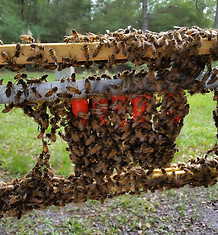
281-468-0019
The Queen Bee
Our Queens
We believe that diversity in the apiary lends itself to better general health of honey bees and gives them the ability to fend off some of the diseases that honey bees can contract. To expand the genetic diversity, we do purchase queens from outside sources, in addition to raising queens in our apiary.
New queens mate with multiple drones, which also adds even more to diversity in the colony. All beekeepers lose colonies at various times due to a number of reasons. In the spring every year we replace lost colonies with either purchased colonies, or splits, which is a beekeeper method of colony-level reproduction.
While queens don’t run the colony, they do keep the bees in their hive busy raising new brood and foraging for nectar, rather than swarming. We love our queens and try to help them do their job by protecting the colony of bees that nurture them.
Queen Info
There is one queen bee per hive - she is the mother of all the other bees. She is the only fertile member of the colony, and lays about 1,500 eggs a day during spring and summer.
Queen bees are distinguished from the other members of the hive by their long abdomens. Soon after birth, queen bees will fly out and mate with 12 or more drones over a several day period before retiring to the hive to lay eggs. The queen will not leave the hive again unless the colony swarms (looking for a new home).
When the colony needs a new queen bee, they simply choose a healthy larva, hatched from an egg of the current queen, and feed it royal jelly, a special, super-nutritious food. Royal jelly is produced by young nurse bees (worker bees whose job it is to care for the larvae). This diet is responsible for this larva grow into a queen. Queens can lay about 1,500 eggs per day and can live 6 years but are usually replaced at two to three years, either by the beekeeper or her workers.




Shown here is one way to replace aging queens. Graft one-day old larvae, let a queenless colony feed the larvae royal jelly to produce a queen cell, then hope the emerging queen can mate well and make it back home to start laying eggs.